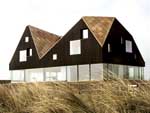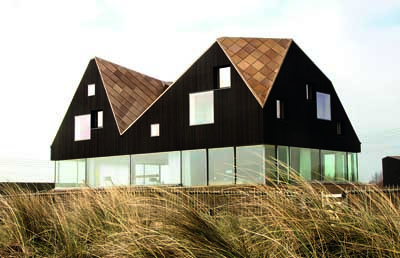How to build your own house
It can be fraught with danger and frustration but building your own house is also immensely rewarding


To build a new house to one's own specification is still one of the most powerful images of fulfillment. It can be an adventure that, since 1999, Grand Designs programmes-and the imitators of the series-have shown us is fraught with hazards for everyone involved, yet, in the right hands, it is one of the great experiences of life.
To do so successfully, it's necessary to filter a large number of factors, based on the available site, with its opportunities and constraints, the needs of the project and its budget to reach a successful design solution. Each threatens over-complication, and the architect's skill is to resolve these into something that feels right or inevitable in terms of spaces, materials and a relationship with the outside world.
Oddly, the result is probably not what anyone first envisaged and its character often seems to be contained in a narrative or metaphor, although preferably not too literally applied, a leading idea around which all the diversity of life can be organised.
Finding the right architect and marrying the dream with practicality isn't easy. For those seeking inspir-ation, one place to look is the entrants for the annual Manser Medal, which is awarded by the RIBA at the same time as the Stirling Prize. Although it doesn't cover all the options, and tends to favour more spectacular designs, it gives a useful view of at least part of the territory.
Stylistically, there is a severe cubic and abstract end of the scale. There are usually several barn lookalikes in rural locations where one can guess that local planners needed reassurance that ‘amenities' would be respected through the familiar form of the pitched roof and a contextual choice of materials. There is the town house, squeezed into a gap in a terrace or totally hidden from the street, as it is only sites such as these that usually become available for new buildings. As well as these, there are commonly commissions where a vernacular cottage is retained for plan- ning reasons and has to be extended in a complementary way, offering an internal dialogue of old and new.
Finally, in most years, the Manser shortlist includes some remote holiday house, a sort of contemplative folly overhanging a mountain stream or facing the waves on the edge of the beach. Curiously, it's these apparently eccentric and peripheral buildings that provide the best clue to understanding what most Modern houses-regardless of their particular form-are trying to achieve.
Having been dogged by endless repetition of his phrase ‘the house is a machine for living in', the Modernist architect Le Corbusier added the words ‘and it is also a useful place for meditation' to emphasise that this wasn't just design by heartless formula, but a question of soul and spirit. Houses of any kind that eliminate the clutter of everyday life have less trouble in being places of meditation, but the aim for Modern houses is to capture an elusive quality of otherworldliness through the bones of the building, its spaces and relationships with light and the outside world.
Sign up for the Country Life Newsletter
Exquisite houses, the beauty of Nature, and how to get the most from your life, straight to your inbox.

All houses have to be objects, but the Modernist idea is to temper their materialism with something intan-gible that goes beyond the substance. It proposes a way of living specially for the people and the place, although others will follow them down the years. Open planning is the leading principle and if it doesn't concern a single undivided space, the architect will still try to make a pathway as if through a garden or woodland, with some distant views and some deliberate interruptions. Sometimes, bedrooms will be below living rooms; staircases become sculptural objects, hanging or hovering. It is a bundle of devices whose cumulative effect, unfolding in time as well as space, is hard to convey from photographs alone.
Liberation from the familiar is not a desire that everyone shares, and there is still a majority market for more conventional designs, both extern-ally in their references to historical models and internally in their more compartmented rooms. As with all forms of architecture, these can be done well or not, and in a variety of styles.
They are invariably at their best when the materials and forms are well matched to each other and employ genuine building skills. These will not be found in the Manser Medal shortlist, although they may come up in the Georgian Group award category of New Building in a Georgian Context. Another important category of work is the rescued historic house. There are many possible approaches to these, ranging from accurate reconstruction to a complete stripping out of the shell of the house and the insertion of a new matrix within it.
The latter, being modern houses by stealth, have become a regular subterfuge in areas of tight planning control, often representing an effective balance between Modernism's special qualities of interior design and the decorum of the street. Across the board, the greatest area of architectural innovation in recent years has been in energy-saving measures, which are now a requirement for new building of all kinds. This is in contrast to the past reliance on electric or fossil fuels to adjust internal temperature. Some architects embrace this new world more enthusiastically than others, but it seems that the era of the self-conscious ‘eco house' is giving way to more invisible incorporation of these requirements in well-insulated materials, discreetly concealed sources of renewable energy and computerised regulation of its use.
Apart from this, however, innovation isn't a salient feature of most Modern houses, whose aesthetic principles still derive from Europe of the 1920s. Really useful or beautiful innovation is not the same thing as a gimmick. With the 100-year mark in sight for the Modern house, it might be thought time for a change, yet the idea of Darwinian development is a false comparison. These ideas show no sign of running out of momentum and still retain their cultural cachet. And pilot projects to bring Modernism to the mass market have a reputation for commercial failure, so Modern houses will probably continue to be a fascinating exotic for us to admire from afar on Channel 4.
Country Life is unlike any other magazine: the only glossy weekly on the newsstand and the only magazine that has been guest-edited by HRH The King not once, but twice. It is a celebration of modern rural life and all its diverse joys and pleasures — that was first published in Queen Victoria's Diamond Jubilee year. Our eclectic mixture of witty and informative content — from the most up-to-date property news and commentary and a coveted glimpse inside some of the UK's best houses and gardens, to gardening, the arts and interior design, written by experts in their field — still cannot be found in print or online, anywhere else.
-
 About time: The fastest and slowest moving housing markets revealed
About time: The fastest and slowest moving housing markets revealedNew research by Zoopla has shown where it's easy to sell and where it will take quite a while to find a buyer.
By Annabel Dixon
-
 Betty is the first dog to scale all of Scotland’s hundreds of mountains and hills
Betty is the first dog to scale all of Scotland’s hundreds of mountains and hillsFewer than 100 people have ever completed Betty's ‘full house’ of Scottish summits — and she was fuelled by more than 800 hard boiled eggs.
By Annunciata Elwes